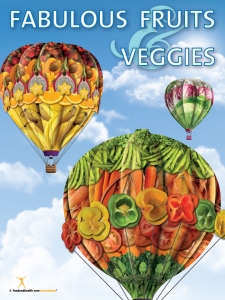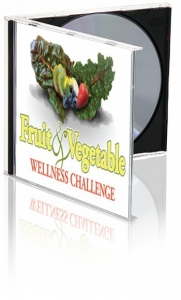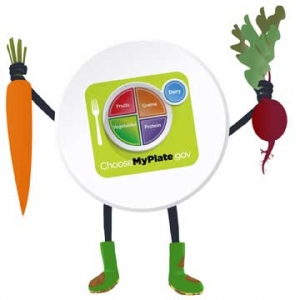Fruits and Veggies More Matters Month: Beyond Fresh Produce
 I love learning from all of you!Today was no exception. You see, I recently got an interesting email from Debra Heverling, MA, RD/LDN. She drew my attention to the fact that "the focus of Fruits & Veggies More Matters (FVMM) Month and the PBH Foundation’s focus is on ALL FORMS meeting our needs—not just FRESH."I took a look at the resources I'd posted and realized that most of them do in fact highlight fresh fruits and veggies over other forms of fruits and vegetables. I totally agree with Debra that "canned fruits and veggies without added sugar or salt can be affordable, nutritious options that do not contribute to... sodium excess... The same is true for frozen fruits and veggies without syrups or sauces."So, for Debra and anyone else who would like an exploration of other ways to celebrate Fruits and Veggies More Matters Month, I'd like to present this brand-new handout: Canned Fruits and Veggies.
I love learning from all of you!Today was no exception. You see, I recently got an interesting email from Debra Heverling, MA, RD/LDN. She drew my attention to the fact that "the focus of Fruits & Veggies More Matters (FVMM) Month and the PBH Foundation’s focus is on ALL FORMS meeting our needs—not just FRESH."I took a look at the resources I'd posted and realized that most of them do in fact highlight fresh fruits and veggies over other forms of fruits and vegetables. I totally agree with Debra that "canned fruits and veggies without added sugar or salt can be affordable, nutritious options that do not contribute to... sodium excess... The same is true for frozen fruits and veggies without syrups or sauces."So, for Debra and anyone else who would like an exploration of other ways to celebrate Fruits and Veggies More Matters Month, I'd like to present this brand-new handout: Canned Fruits and Veggies.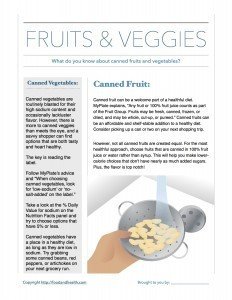
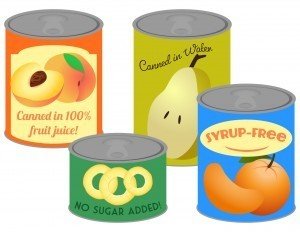 Canned Fruits:Canned fruit can be a welcome part of a healthful diet. MyPlate explains, “Any fruit or 100% fruit juice counts as part of the Fruit Group. Fruits may be fresh, canned, frozen, or dried, and may be whole, cut-up, or pureed.” Canned fruits can be an affordable and shelf-stable addition to a healthy diet. Consider picking up a can or two on your next shopping trip.However, not all canned fruits are created equal. For the most healthful approach, choose fruits that are canned in 100% fruit juice or water rather than syrup. This will help you make lower-calorie choices that don’t have nearly as much added sugars. Plus, the flavor is top notch!
Canned Fruits:Canned fruit can be a welcome part of a healthful diet. MyPlate explains, “Any fruit or 100% fruit juice counts as part of the Fruit Group. Fruits may be fresh, canned, frozen, or dried, and may be whole, cut-up, or pureed.” Canned fruits can be an affordable and shelf-stable addition to a healthy diet. Consider picking up a can or two on your next shopping trip.However, not all canned fruits are created equal. For the most healthful approach, choose fruits that are canned in 100% fruit juice or water rather than syrup. This will help you make lower-calorie choices that don’t have nearly as much added sugars. Plus, the flavor is top notch!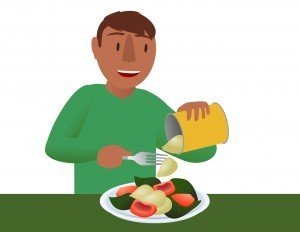 Canned Vegetables:Canned vegetables are routinely blasted for their high sodium content and occasionally lackluster flavor. However, there is more to canned veggies than meets the eye, and a savvy shopper can find options that are both tasty and heart healthy.The key is reading the label.Follow MyPlate’s advice and “When choosing canned vegetables, look for ‘low-sodium’ or ‘no-salt-added’ on the label.”Take a look at the % Daily Value for sodium on the Nutrition Facts panel and try to choose options that have 5% or less.Canned vegetables have a place in a healthy diet, as long as they are low in sodium. Try grabbing some canned beans, red peppers, or artichokes on your next grocery run.Of course, there's lots more to the story than canned foods. When you're helping your clients figure out ways to incorporate fruits and vegetables into their diets, having a few resources that address frozen foods can be useful as well. Check out the member-exclusive post Fruits and Veggies More Matters Month: Frozen Fruits and Vegetables and get your copy of the brand-new handout that comes with it!
Canned Vegetables:Canned vegetables are routinely blasted for their high sodium content and occasionally lackluster flavor. However, there is more to canned veggies than meets the eye, and a savvy shopper can find options that are both tasty and heart healthy.The key is reading the label.Follow MyPlate’s advice and “When choosing canned vegetables, look for ‘low-sodium’ or ‘no-salt-added’ on the label.”Take a look at the % Daily Value for sodium on the Nutrition Facts panel and try to choose options that have 5% or less.Canned vegetables have a place in a healthy diet, as long as they are low in sodium. Try grabbing some canned beans, red peppers, or artichokes on your next grocery run.Of course, there's lots more to the story than canned foods. When you're helping your clients figure out ways to incorporate fruits and vegetables into their diets, having a few resources that address frozen foods can be useful as well. Check out the member-exclusive post Fruits and Veggies More Matters Month: Frozen Fruits and Vegetables and get your copy of the brand-new handout that comes with it!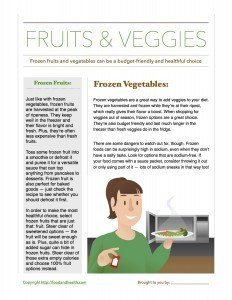 There are lots more resources for Fruits and Veggies More Matters Month in the Nutrition Education Store! Which will be your new favorite?
There are lots more resources for Fruits and Veggies More Matters Month in the Nutrition Education Store! Which will be your new favorite?